1. Bill, the son
Bill dressed for a school play, age 11
When Bill talks about his early years,
he usually tells
two stories and with special pride. One is from a game of
a softball
variant of baseball (Softball pitched overhand from 57.5
feet with 75 feet between bases
and hardball rules) that Bill played while in graduate school in
Linus
Pauling's group at the California Institute of Technology.
The
game was called intermediate baseball and was played for a short
time
during World War II before disappearing.
When Bill Lipscomb was young, he set up a chemistry lab at
home.
Bill made gunpowder for homemade fireworks from chemicals he
purchased at a local pharmacy.
First, he mixed the ingredients. Then, he began to
grind.
He stepped back. He does not know why. Up rose a
fireball.
Bill formed a musical troop with his sisters. He played
the clarinet while they danced.
Then, tragedy. Bill’s sister Helen in 1937 at age 17
caught
polio.
To finish the last two years of high school from her bed Bill
taught
her mathematics, and a teacher visited to teach other
courses.
Helen lost her dreams of an ordinary life, a husband and
children, and
Bill's father lost not just his job, he lost his career.
No one would bring their child to the Doctor from the house of
polio. He re-trained to become a psychiatrist.
In the meantime Bill had to go to an inexpensive college, the
University of
Kentucky on a music scholarship as a marching clarinet player
[KentuckyAlumnus1976-1977] with help from his summer job
distributing seeds to farmers. He donated his home
chemistry lab
to his high school, more than doubling their equipment.
When his college chemistry professors saw how much Bill could
handle,
they bumped up the quality of some of the courses to the dismay
of the
other
students. They asked Bill to tell the professors that he
could
not follow at this greater pace. Bill's
answer is unknown, but he tends towards the truth.
Bill's father, however, could tell a tall tale. On his
50th wedding
anniversary he and his wife dressed up and took their daughter,
Helen, to a nice
restaurant. The waitress asked, “What’s the
occasion?”
Bill’s father indicated his middle-aged, wheelchair-bound
daughter and
deadpanned, “For her peace of mind we finally decided to get
married.” I am told that the waitress did not speak to
Bill’s father for the rest of the evening. BIll's dry
sense of humor may have some origins here.
2. Bill, the father
Bill Lipscomb was distinguished long before he was awarded the
Nobel Prize in Chemistry in 1976. By
way of coping we children dubbed him Sir Father. Bill took
particular delight that when his guests remarked on how polite
his
children were, calling their father, Sir, that they did not also
notice
that we were smirking.
For now, he will be Bill. Formality does not suit
him. To his students he is The Colonel, or directly
addressed as
Colonel. "His first doctoral student, Murray Vernon King,
pinned
the label on him, and it was quickly adopted by other students,
who
wanted to use an appellation that showed informal respect.
...
Lipscomb's Kentucky origins as the rationale for the
designation."
[Katz2000]
Indeed, in 1973 Bill really was made an honorary Kentucky
Colonel, of all his awards the only one that hangs in his
bedroom. He
gleefully explained that the award was in a sense meaningless in
that
it was nothing more than an honor.
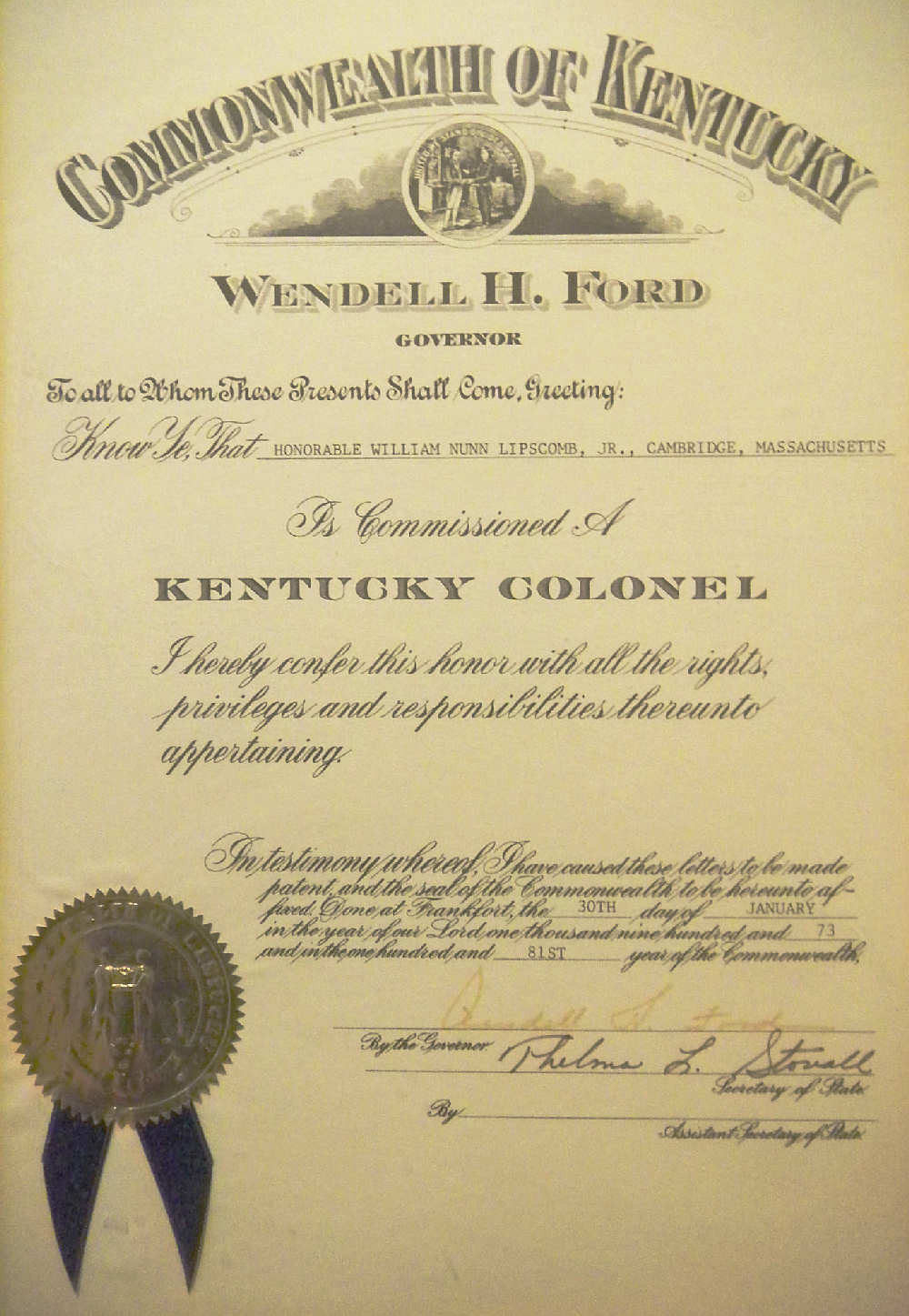
Bill's honorary Kentucky Colonel certificate
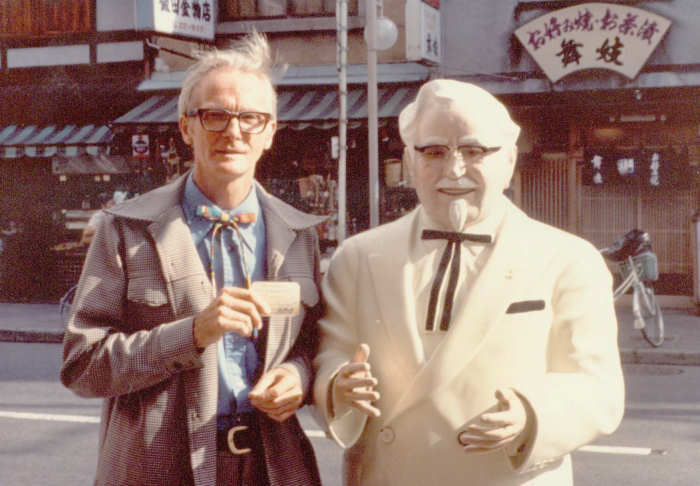
Bill in Japan holding his Kentucky Colonel card by a statue of Colonel Sanders.
Photo © 1979 Jean C. Evans under a Creative Commons Attribution 3.0 Unported License.
(You are free to copy, distribute, etc. with attribution)
There were two rules in the early Lipscomb household.
- Don’t wake daddy. If he does not get a long night’s
sleep,
then his science work would lose a day, as he could not work
on anything
hard. From an Internet search for quotations
from Bill:
- As your knife traveled from the butter dish to your dinner
roll, the butter on the knife was fair game to a swooping
attack,
diverting the butter to ones own roll. This was a
surprise to the
occasional dinner guest. That is when Bill did the
honors.
The rest of us were too polite.
Bill pushed a bowl towards the dinner guest.
"Have a walnut."
The guest picked the one on top, and cracked it open as she
continued talking. When she saw just the cracked shell and
nothing more in her
hand, she stared in disbelief and
disappointment. The day before, Bill had gently cracked
that walnut into
two unbroken halves, scooped out the inside, and glued the shell
back
together.
For the son of Bill Lipscomb the early years included advanced
science
books given to a young boy. In grade school along with Dr.
Seuss’s books Bill stocked my bookshelf with The Restless Universe by
Max Born, One, Two, Three,
Infinity by George Gamow, and the Mr.
Tompkins physics books. He also gave me a college
textbook, Astronomy an
Introduction by Robert Baker, and I studied it. I
began to be interested in physics and particularly, in one of
these
books, in the Minkowski diagram, which really puzzled me.
The
axes of space and time rotate to calculate the distortions of
space-time near the speed of light, but it wasn’t quite clear if
these
axes really rotated in the natural world, or if they rotated
only
mathematically to explain the phenomenon, and I puzzled over
that a
while.
One of Bill's World War II military research
projects
during graduate school had him sometimes
carrying vials of pure nitroglycerin. Bill told me that it
was
safest to hold the vials by the bare fingertips, so that the
heat of one's hand might not detonate the solution, knuckles out
to absorb shock, and that not
wearing gloves reduced
the
chance of dropping a vial. Later, Bill taught me four
precise
steps for how to handle dry ice
with my bare hands. When I was in early grade school, Bill
showed
me that
centrifugal force would reduce the chance that we would slip and
fall when we left the
fenced trail to run behind and half-way up the Minnehaha
Falls
in Minneapolis Minnesota on a semi-circular,
wet, narrow, ledge that sloped down to the rocks perhaps 20 feet
below. I suppose that
all fathers give their sons safety tips.
Bill bought a Sears and Roebuck air rifle [Lipscomb1977] when I
was in high
school so that I could dispose of vials his labs old
experimental solutions,
glass ampoules of boranes that
exploded on contact with
air. There was no company or agency that would take care
of
it. Bill paid for the air rifle himself, as he did with
the
many sets of poker (or maybe bingo or roulette) chips he bought
to tape
to the hanging clear plastic sheets of the carboxypeptidase A
electron
density map to indicate atomic positions. He did not
want to have to explain billing the granting agency. The
beginning and the end of the air rifle era are told by Donald
Voet in
the great air rifle caper.

Bill's air rifle
My
fireball arrived in the air rifle era when a graduate
student heated a tube on a glass vacuum line and pulled off
a sealed ampoule. It held 1 cubic centimeter of liquid
diborane,
which
explodes with a sharp crack (and violently; 1 cc is a lot),
mixed with
5
cc of pentaborane, which flames for a second or two. The
ampoule
was
too dangerous to carry up to our roof-top shooting
range, because the compounds within explode on contact with air,
so the
tiniest crack in the glass could set them off. Gently the
student
put the ampoule in a metal dewar
(heavy-duty thermos bottle) and placed it, now a flamethrower
pointing up, on the Gibbs
Lab fire escape at the right-hand pane of the
big window centered in the photo.
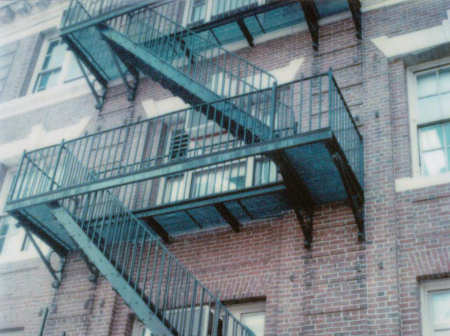
Gibbs Lab fire escape
On
the grating a floor
above (upper left of photo) someone laid down a sheet of safety
glass. I
knelt down on it and shot the air rifle just over the
edge diagonally down (down and to the right in the picture),
into the upward-pointing mouth of the
dewar.
I was too close to the explosion to see it. Behind my
safety glasses
I flinched from intense heat as
the dewar
blasted a fireball up past the window partly visible at top
center. Then the crowd. I opened my eyes to see,
across
the parking lot, visitors queued for a back door of the Peabody
Museum
all looking
towards Gibbs. Graduate students in the room (not visible
beyond
the upper right) above the rightmost half-visible window came
out surprised
and slightly
concerned, as the expanding radius of the fireball was
sufficient for it to pass
their window. Having a chemist for a dad can be very
cool.
3. Billy finds his profession
Boy
Scout rank advancement ---> outdoorsman
----> astronomy and chemistry ---->
stars
----> how stars work ----> molecules,
particles, waves ----> physical chemistry
Whenever
Bill's father served as a physician at Boy Scout summer camp he
brought
young Bill with him. Bill became a Star Scout (two
ranks below Eagle Scout) and an enthusiastic
outdoorsman. Later he would drive his young family 200
miles north of St. Paul, Minnesota, for a few weeks in two
summers in a
log cabin on the shore of Deer Lake, close to Little
Deer Lake, living on the fish we would catch. Back
in his youth, while camping in the open in his sleeping
bag, a
meteor shower started in which the meteors were so bright and
frequent,
every few seconds, that they woke him up.
When Bill talks about his early years, he usually tells
two stories and with special pride. The other one is of an
advanced science book given to him by Prof. Harold H. Downing,
professor of mathematics and astronomy at the University of
Kentucky.
As we open the front cover we see that Bill's mother, Edna, has
written
Bill's name, address, and phone number. Bill wrote the
date,
1932. He was about 12 years old, the year that his mother
gave him a chemistry set, which grew into a home chemistry lab.
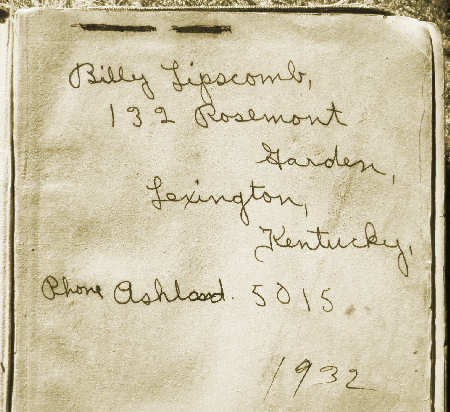
As we flip the pages, we see that they are wrinkled from a night
in the rain in the little tree
house that Bill built. As we flip
the pages time passes, tastes change.
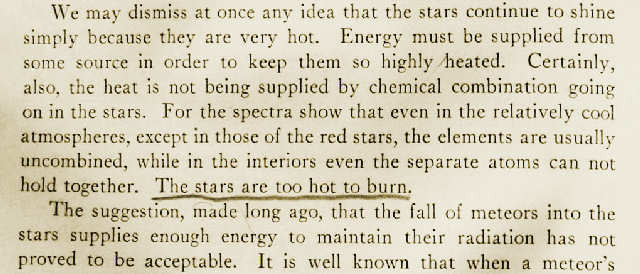
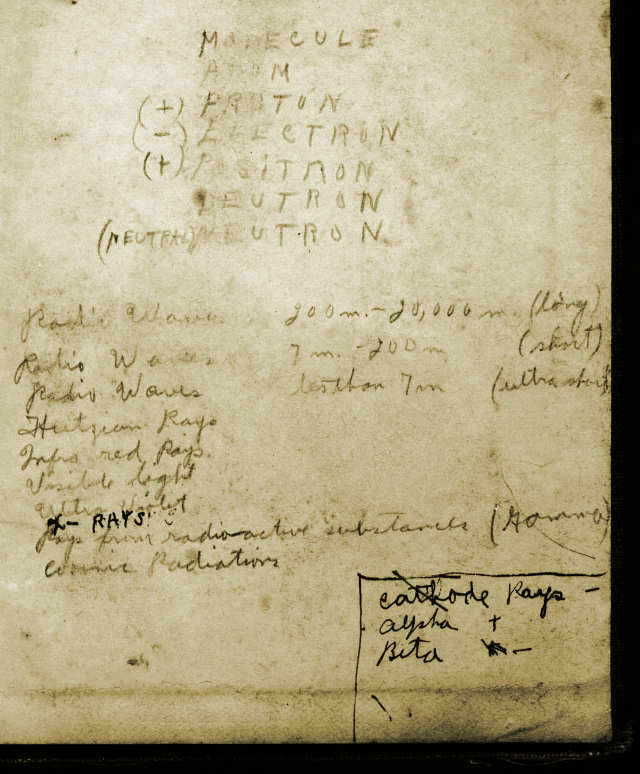
 Home page https://wlipscomb.tripod.com/
Home page https://wlipscomb.tripod.com/